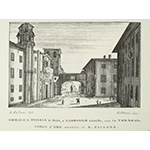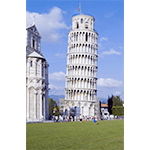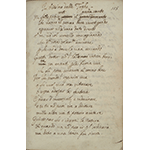First teaching positions (1589-1592)
Galileo returned to his native city when, after having repeatedly failed to find a university position, he obtained the Chair of Mathematics at the Studio of Pisa, thanks to the support of Guidobaldo del Monte and his powerful brother, Cardinal Francesco Maria. Here he earned enough to live on and was also able to make a useful contribution to the depleted resources of his family. Unlike his predecessors, Galileo did not include the subject of astrology in his courses, but in all three years of teaching he read Euclid (the first and fifth books of the Elements). This early enthusiasm however soon cooled. Guidobaldo wrote to him, in reply to some complaint about his low salary, saying, 'I am not entirely happy, because I would like to see you more content and treated better, in keeping with your merits.' Galileo repeatedly absented himself from his teaching duties and was even fined for this, which reduced his modest salary still further.
The academic milieu was the same that he had abruptly abandoned some years before and was certainly not favourable to the development of his research, which for some time had been concerned with the motion of falling weights. The ever-laudatory Viviani describes his 'repeated experiments, made from the top of the Leaning Tower of Pisa in the presence of other teachers and philosophers and the entire student body', in which Galileo demonstrated the falsity of 'very many conclusions of Aristotle himself', to whom the concept of specific weight, central to Galileo's interpretation of the phenomena of motion, was unknown.
Whether or not the experiments in dropping weights from the Leaning Tower actually took place (and it is plausible given that other researchers in this field are known to have conducted such experiments), it is the case that Galileo's theories on motion were already in conflict with some cardinal points of Aristotelian physics relating to the concepts of velocity, gravity and the void, which, inserted in a new theoretical system, assumed connotations different from those familiar in the traditional system. Underlining, moreover, Aristotle's total ignorance of mathematics and geometry, a knowledge of which is indispensable to 'distinguish the true from the false,' Galileo stood in open conflict, as regards scientific method, with the followers of Aristotle at the University of Pisa, some of whom, formerly his teachers, had now become his colleagues.
Galileo's Against wearing the Gown emphasizes the difference between appearance and substance, between dressing the part of a scientist and really being one. It came naturally to him as a frequenter of the taverns of Pisa,
at Bertuccie, at the Porco, at Sant' Andrea
at Chiassolino or at Malvagia,
to conclude by comparing men to flasks. Some, at first glance so unappealing that not even a second-hand dealer would want them, actually contain excellent wine.
The rest , who wear those delicate gowns,
if you feel them, are full of wind,
or of cosmetics, or of perfumed water,
or are old flasks good to piss in.
In 1592 Galileo left Pisa for Padua and it is clear that this was a forced move. From that time on, the weakness of his ties with Pisa is made clear in the sporadic and insignificant nature of his contacts with the city. Even when, some twenty years later, he was appointed Chief Mathematician to the University of Pisa, he asked to be dispensed from teaching and was readily granted his request, on the strength of the fame he had acquired during his years in Padua through the construction of instruments such as the compass, and in particular the telescope, which had made possible the new astronomical discoveries of 1609-1610. In Pisa Galileo demonstrated these discoveries from the Torre della Verga d'Oro, in the presence of the grand-ducal family, and he was given the title of Chief Mathematician and Philosopher to the Grand Duke. This allowed him to live in Florence without financial difficulties.
****************************
Texts by Sara Bonechi
English translation by Anna Teicher
Last update 16/gen/2008








